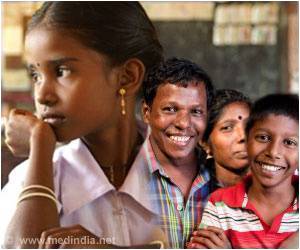
And this loss could reach 22 million globally by 2100 if all countries at risk of boosting this ratio above its natural level, including densely populated countries, such as Nigeria and Pakistan, do so, warn the researchers.
‘Sex ratio at birth need to be monitored in countries with son preference and to address the factors behind the persistence of gender bias in families and institutions.’
Prenatal sex selection has helped skew the sex ratio at birth in favor of boys in several countries from South East Europe to South East Asia since the 1970s, say the researchers.
The consequences of this preference will create a surplus of young men in more than a third of the world’s population, with the full social and economic impacts as yet unknown, they suggest.
To better understand the extent of ‘missing’ female births to inform policies against prenatal sex selection and to plan for the impact of future changes in sex structures across the world, the researchers projected the sex ratio at birth for all countries from 2021 to 2100, using two scenarios.
Scenario 1 assumed trends only for countries with strong statistical evidence of an increasing imbalance in sex ratio at birth, while scenario 2 assumed sex ratio trends for countries at risk of increasing the ratio, but with no or limited evidence of this.
The projections were based on a comprehensive database of 3.26 billion birth records from 204 countries from 1970 to 2020 as well as the experience of countries facing rising sex ratios at birth before 2021.
The researchers focused particularly on 12 countries where the sex ratio at birth has already increased plus 17 other countries at risk of this because of a preference for sons and a decline in fertility.
The projections showed that the sex ratio at birth is most likely to stabilize and then decline within 20 years in countries currently affected by a surplus of liveborn boys, such as China and India, which have the highest number of annual births in the world.
READ RELATED: Coronavirus: Bolton asks for restrictions to remain after spike
Nevertheless, under scenario 1 the researchers still projected a deficit of more than 4.7 million female births between 2021 and 2030, with a further 1 million between 2031 and 2100. Under scenario 2, if all countries with a preference for sons at risk of increasing this ratio, such as populous countries like Pakistan and Nigeria are included in the calculations, the projected figure rises to 22.1 million by 2100, with sub-Saharan Africa making a sizeable contribution (almost 38%).
The researchers acknowledge various potentially important limitations to their calculations. These include the need to improve the estimates of baseline sex ratios at birth and the numbers of sex-selective abortions in the absence of reliable and systematically collected data. And inevitably, long term projections will be subject to as yet unknown factors.
But a surplus of men in a society could lead to a “marriage squeeze” because of insufficient numbers of marriageable women and/or an increase in antisocial behaviour and violence, all of which may ultimately affect long term stability and social sustainable development, they suggest.
“These findings underline the need to monitor [the sex ratio at birth] in countries with son preference and to address the factors behind the persistence of gender bias in families and institutions,” they write.
More needs to be done to collect better quality data and to implement direct and indirect measures to combat gender bias, they add.
“A broader objective relates to the need to influence gender norms which lie at the core of harmful practices such as prenatal sex selection. This calls for broader legal frameworks to ensure gender equality,” they conclude.
Source: Eurekalert
Source:










